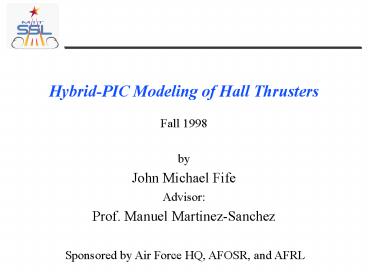HybridPIC Modeling of Hall Thrusters - PowerPoint PPT Presentation
1 / 25
Title: HybridPIC Modeling of Hall Thrusters
1
Hybrid-PIC Modeling of Hall Thrusters
- Fall 1998
- by
- John Michael Fife
- Advisor
- Prof. Manuel Martinez-Sanchez
Sponsored by Air Force HQ, AFOSR, and AFRL
2
Outline
- Introduction and Motivation
- Numerical Modeling
- Discussion
- Summary and Recommendations
3
Introduction
Typical Hall Thruster Characteristics (SPT-70)
4
Motivation
- Hall thrusters are increasingly being selected
for space missions requiring optimal specific
impulse of around 1600 s. - Lifetime of 7000 hrs is limited by erosion from
ion impact. - High-amplitude discharge oscillations are
problematic. - Understanding of the acceleration process is
incomplete.
5
Related Research
- Bishaev, Kim, 1978 -- measurements inside the
acceleration channel using electrostatic and
emissive probes - Komurasaki et. al., 1991 -- measurements and 1-D
modeling - Hirakawa, M., and Y. Arakawa, 1995 -- 2-D PIC
simulation -- good basic results using
nonphysical parameters - Lentz, C., 1993 -- 1-D numerical model with Bohm
diffusion -- predicted performance of Komurasaki
thruster
6
Objective
- Construct a flexible 2-D numerical model using
physical parameters which can be used for - Basic Science
- Engineering
- Performance
- Lifetime
- Spacecraft Interaction
7
Numerical Modeling
- Better understanding of the plasma acceleration
process - Predict performance and lifetime
- Provide data for spacecraft interaction studies
- Result a flexible tool useful for thruster design
8
Numerical Modeling
Hybrid-PIC Method
PIC Method
Te, ?
?t 5e-11 s
nn, un, ni, ui
?t 5e-8 s
9
Numerical Modeling
Innovations in PIC Methodology
- Particle follower for non-uniform grids
- Variable particle mass
- Constant ionizations per cell
- Background pressure modeled
r
z
10
Numerical Modeling
Electron Equations
Charge Neutrality
Isothermal Along B
Across B
Continuity
Ohms Law
Conservation of Energy
11
Numerical Modeling
Electron Cross-Field Mobility
12
Numerical Modeling
Particle-Particle Collisionality
Ionization
Electron-Neutral Inelastic Collisions
Cross-sections from Drawin, 1961
Dugan et. al., 1967
13
Numerical Modeling
Computational Cost
- 20,000 lines of active C code
- B-field computation takes 6 hrs
- Simulation takes 4 hrs for convergence
- Time shared equally between particle mover and
electron fluid integrator - 80 of computing power goes to relating solutions
on three grids (physical, computational, and
magnetic field)
Computing times are for an SGI Octane workstation
14
Numerical Modeling
Magnetic Field Computation
? T m
15
Results from Numerical Modeling
Vp V
Te eV
ne m-3
nn m-3
CASE 2 SPT-70, 300V, 2.34 mg/s, NEAR CATHODE
16
Numerical Modeling
Performance Comparison
17
Numerical Modeling
Distribution of Ion Energies
18
Numerical Modeling
Facility Interaction
Model for measured utilization efficiency
Thrust efficiency comparison
MODEL
NASA LEWIS
Sankovic, et. al., 1994
19
Numerical Modeling
Utility of the Model in Design and Spacecraft
Integration
Parameter
Estimated error
- Performance
- Torque
- Wall erosion rate
- Facility interaction
8
0
48
3
using CASE 2
20
Numerical Modeling
Ionization Oscillations
21
Comparison Between Model and Experiment
Isothermal Assumption Along Lines of Force is Not
Quite Right
Te eV
Isothermal
Adiabatic
Worst-Case Measured
22
Comparison Between Model and Experiment
Acceleration Layer Outside the Channel is not
Observed Experimentally
Vp V
Vp V
Numerical Model
Electrostatic Probe Experiment
- Possibilities
- Near-Wall Conductivity
- Electron Loss to the Metallic Body
- Anomalous Diffusion
23
Comparison Between Model and Experiment
Losses to Thruster Body
Anomalous Conductivity
e-
Br
e-
e-
e-
z
SPOKE IONIZATION WAVES, TRANSPORT-TIME
INSTABILITY
AZIMUTHAL DRIFT WAVES
Localized enhancement of cross-field electron
mobility possible.
But these values should be independent of (Ia-Ib)!
24
Summary and Conclusions
- The numerical model is a powerful
state-of-the-art tool for basic research of Hall
thrusters. - Predictions can be made of real thruster
performance, lifetime, torque, facility effects,
and spacecraft interaction. - Much about the acceleration process is still not
well understood.
25
Recommendations
- Further investigation of the cross-field
transport of electrons - Reformulation of quasi-one-dimensional electron
equations to include an energy balance along
lines of force - Refine models for plasma-metal contact
- Consider using a brute-force particle-particle
approach in anticipation of parallel computing
developments

